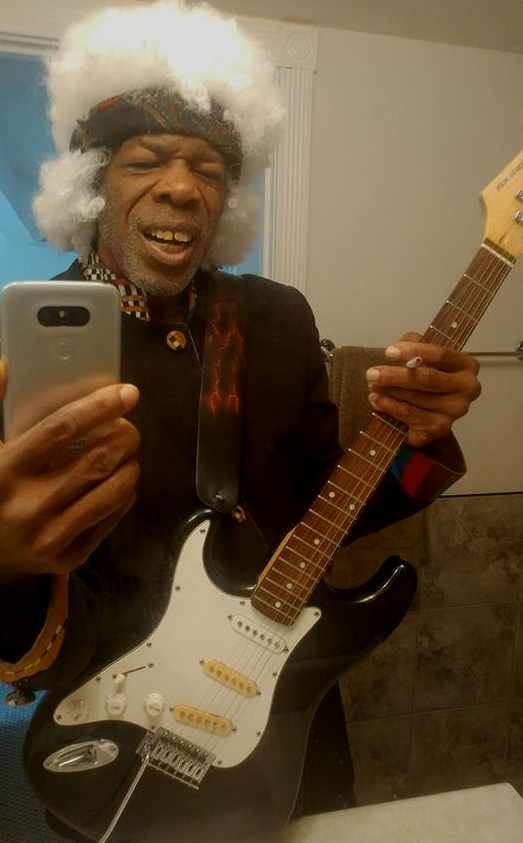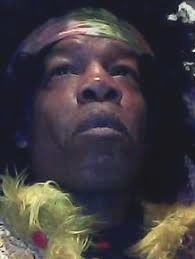It’s
yet another gross, overcast Sunday afternoon in this miserable
spring and I’m hanging with my man Milford Kemp in the almost
impossibly tiny apartment of the Mile End rooming house he’s
been calling home lately. The usually up-beat Milford is feeling
slightly irritable today, pissed at the weather which has been
keeping people away from the Tam Tams en masse this season, and
by extension,  compromising
the few extra dollars he’s come to count on as a street
performer of sorts.
compromising
the few extra dollars he’s come to count on as a street
performer of sorts.
His digs
are Spartan to say the least. His furnishings include a cot and,
well, that’s about it. I’ve found a shitty little
practice amplifier to use as a chair and can’t help but
noticing that while his apartment is certainly clean, there’s
a strong odour coming from somewhere nearby, an odour I can only
describe as smelling like cunt – and not in a good way either.
More like a yeast infection. Every wall in the roughly 150 square
foot room has clothes hanging from it, most being pretty nifty
threads Milford designed and sewed himself. He tells me that he
never leaves his house without changing his clothes, if he comes
and goes five times from his apartment he’ll wind up wearing
five different ensembles that day. “I dress to be rebellious,”
he says.
If you
get out much there’s a pretty good chance you’ve seen
Milford around. He’s certainly not hard to miss, given that
he’s probably the only good-looking black guy for miles
around who struts around town all done up as some kind of a fucked
up middle-aged Jimi Hendrix look-a-like, on a good day with a
bit of pimp attire thrown in for good measure, the feathered hat
etc. “People always think I’m either a pimp or a drug
dealer, the only things people in Quebec figure a black guy could
ever be. And I am a pimp, but I pimp clothes, not ho’s,”
he tells me, referring to his days as a textile/clothing designer
back in the 80s, when, still living in his home town of Los Angeles,
he started a clothing line that people like David Lee Roth, Grace
Jones and Chad Smith from the Chilli Peppers all wore at one time
or another. Consistent with the luck Milford has experienced throughout
life to date, however, the Milford Kemp clothing/textile line
was only in business a short while, folding after a series of
mob-related crooks apparently ripped him off, stole his best ideas
and left him broke and thoroughly disheartened in the process.
He tells
me nothing would make him happier than to design clothes for people
again, but his ideas are just too wild for the average Montrealer
and nobody here takes him seriously anyway. I can’t help
but wonder if these are people who’ve seen him doing his
Jimi Hendrix street performance thing at the Tam Tams, where he
can be found jumping around maniacally playing air guitar to a
tape of “Are You Experienced.” I suspect they are.
After all, even if 58-year-old Milford does -- once he’s
slapped his wig on, at least -- bear an uncanny resemblance to
Hendrix, well, the spectacle doesn’t exactly inspire confidence
in the state of his mental health. “I only do my Jimi show
because I’m a frustrated artist,” Milford reminds
me. “It helps me blow off steam.  Besides,
before I started doing it people here wouldn’t even look
at me, they were scared of me, this black man. Now at least some
people go “Hey Jimi”, when they see me on the street
-- when they’re not yelling “Nigger” at me from
their cars, that is. But I hardly make any money from it. Some
days I can’t afford to even eat, you know?”
Besides,
before I started doing it people here wouldn’t even look
at me, they were scared of me, this black man. Now at least some
people go “Hey Jimi”, when they see me on the street
-- when they’re not yelling “Nigger” at me from
their cars, that is. But I hardly make any money from it. Some
days I can’t afford to even eat, you know?”
While
Milford’s Jimi act might have earned him a little local
notoriety -- he did, after all, place seventh in the Mirror’s
BOM Best Montreal Weirdo category in 2011 -- it might also help
to explain why few people are apt to believe him when he relates
his life story, which is sort of understandable. I mean, who would
believe that this eccentric freak they see hopping around on the
mountain every weekend was at one time a champion boxer who not
only battled Leon Spinks and very nearly won the bout, but also
created the aforementioned clothing line and arrived in Montreal
by invitation of one Louise LeCavalier of LaLaLa Human Steps,
the celebrated dancer who he’d spent time training back
when he was teaching 'ballet boxing' and self-defence classes
for women in Los Angeles. Oh, and let’s not forget his eight-year
romantic relationship with a certain member of Jacques Parizeau’s
extended family who apparently fast-tracked his Canadian immigration
application, or the fact that he began his 20s as a very promising
professional dancer/choreographer.
I mean,
if those claims don’t sound like the self-aggrandizing lies
of a street crazy I don’t know what does. Yet everything
Milford says that can be verified has checked out. Hey, most of
it is there for all to see in Milford’s self-produced, self-directed
film American Trash, which can be experienced via Youtube
or on a DVD Milford will happily sell you for a whopping two bucks.
“Except nobody even wants to even pay me that much for it,”
Milford complains. “I bring copies to the mountain every
weekend but hardly ever sell one.” If you still doubt his
credibility, go take a look at his Facebook page, where among
the photos you’ll find of his genuinely impressive artwork
you can get a glimpse of his life so far. “Hey, I won hundred
bucks for somebody last week who bet another guy that I’d
fought Spinks back in the 70s. The guy figured there was no way
I’d done that, but after he went online, ha, ha, well, he
was out $100.”
While
Milford’s talent and numerous accomplishments over the years
are definitely impressive, there’s little doubt the most
remarkable claims coming from the man involve his boxing career.
“I
was studying classical ballet under Eugene Loring in Irvine when
Ali was vindicated by the Supreme Court. This guy was a hero to
me and so many other black people that I really wanted to choreograph
something on him. But to do it well I had to learn how to box
first, which I did, and I turned out to be pretty good at it.
Ten months later I’d had ten fights and qualified for the
National Tournaments in Vegas, which is where I fought Spinks,
in the finale. I was ranked fifth nationally in my weight division
after boxing for less than a year. You see, when I was little
my mother used to strip me naked and beat me so badly I’d
developed an immunity to pain, and that helps a lot for a boxer.”
Except
Milford was no ordinary pugilist. He perfected something he calls
ballet boxing, a unique approach to the sport that had the effect
of thoroughly confusing his opponents yet, at the same time, so
crazily unorthodox that he drove his coaches insane. “Think
of James Brown boxing, that’s what I did, and in a very
dramatic way too. The thing is, I’m an artist and I just
saw boxing as art, which is why my coaches never understood or
got along with me. Later, when I was on the US Olympic team they
wouldn’t even let me do ballet boxing. They all saw me as
a clown, except I kept winning fights.”
“I
fought Spinks like I’d fought everyone else to that point,
pulling punches even when I had him cornered. He couldn’t
understand it. He got so frustrated, like my pulling my punches
was an insult to him, but I knew I didn’t need to hurt him
to win points. And man, I was beating him, like, four punches
to one, and it was a huge upset. I knew I’d won but the
judges awarded him the decision. Leon also knew I’d beat
him, he even came up to me afterward, his head hung in shame saying
“I’m sorry, man.” The whole thing didn’t
seem right to me but I figured the judges had their reasons for
giving him the fight. It was only later when I really learned
what happened from my Olympic team doctor, who told me that by
whoopin’ Spinks I’d nearly blown a million dollar
deal, that after he won the Olympics he had millions of dollars
lined up, nobody was supposed to beat him, and then I come along
and upset him in what was only my tenth fight. Me, this ballet
boxing clown. Spinks was already supposed to be fighting Ali for
big money then, so my beating him would have messed everything
up. They figured it was a fluke, that maybe he’d just had
a bad day. That’s when I understood boxing is all manufactured.”
Shortly
after the Spinks fight, a disillusioned Milford decided to get
out of the ring and go back to focusing on dance and his artwork,
which eventually led to his developing his clothing/textile line.
“You’ve got to understand, I grew up with Martin Luther
King in the ‘60s and I’d come to feel that to beat
up a man was to degrade a man. I saw boxing as art, but art is
creative when boxing is destructive, so I just didn’t want
to do it anymore.”
For
the next 10 years Milford pursued only artistic endeavours, working
his clothing line and creating visual art projects until his mother
passed away. “After she died I realized I was finally free,
and I was so disappointed by what had happened to my clothing
business that I got back in to boxing and started fighting to
hurt people. I didn’t care anymore, I’d lost total
respect for boxing by then. So I fought until I was blind, until
my retina was detached from my eye. And when they wouldn’t
let me fight in the States because of it, I went down to Mexicali
and fought there. I’d take dives if I felt like it. I was
32 years old then and my fee was $1000 a round. So if they told
me they only had $2500 to pay me, I’d say “fine, but
I’m either knocking someone out or going down half-way through
the third round.” It didn’t matter to them but I felt
disgusted, I was prostituting myself, I was no better than the
whores of Mexicali, except they sold pleasure where I sold pain.”
Blind
in one eye, sickened by his profession, too battered and old to
be taken seriously by the boxing community, it wasn’t long
before Milford abandoned boxing for good, this time opting to
start up a self-defence/ballet boxing class primarily for female
rape victims. “The stories
these women told me made me ashamed to be a man. I had to do something,
anything to help them feel better again.” Through  one
of his ballet boxing classes he was introduced to LaLaLa Human
Steps dancer Louise LeCavalier, who, as impressed with Milford’s
talents as he was with hers, recommended he come to Montreal where
she’d hook him up with some of her contacts. Which he did,
working on film and choreography projects for awhile, shacking
up with his Parizeau gal and earning his Canadian permanent residence
status. For awhile Milford was doing just fine here, but, as so
often in his life, with time everything turned to shit, and once
the lengthy romantic relationship he had with his wealthy, politically-connected
benefactor had run it’s course, he says he had no choice
but to live “in the bushes by the highway” for far
too long, broke, broken, and very far away from home.
one
of his ballet boxing classes he was introduced to LaLaLa Human
Steps dancer Louise LeCavalier, who, as impressed with Milford’s
talents as he was with hers, recommended he come to Montreal where
she’d hook him up with some of her contacts. Which he did,
working on film and choreography projects for awhile, shacking
up with his Parizeau gal and earning his Canadian permanent residence
status. For awhile Milford was doing just fine here, but, as so
often in his life, with time everything turned to shit, and once
the lengthy romantic relationship he had with his wealthy, politically-connected
benefactor had run it’s course, he says he had no choice
but to live “in the bushes by the highway” for far
too long, broke, broken, and very far away from home.
These
days he survives on welfare and whatever change his crazy Jimi
Hendrix act brings in. “Ain’t no ads looking to hire
a 58 year old black man in the newspapers, you know what I’m
sayin’?” He dreams of the day a patron might appear
out of nowhere and offer him the money he needs to start painting
again, or open a local ballet boxing studio, or help him realize
his latest clothing designs, or give him something new to choreograph,
or present him with pretty well any new creative vehicle he might
be able to earn a couple bucks through. Until that glorious day
arrives, however, chances are Milford will still be up on Mount
Royal every Sunday doing his Jimi spectacle for a bunch of white
kids who like to call him nigger and have zero clue that Montreal’s
Seventh Best Weirdo is one of the most genuine dudes they’ll
likely ever meet – looney tunes or not.
Also
by Chris Barry:
Like
Young
Loving
Hard Times
Feed
Your Head
Talking
12-Tone with Patti Smith
Beauty
Pageants: The Golden Years
Swingers'
Clubs as Safe Zones
Bust
a Move
Trapeze
- Swinging Ad Extremis
Hells
in Paradise
The
Cannabis Cup
Colonic
Hydrotheraphy